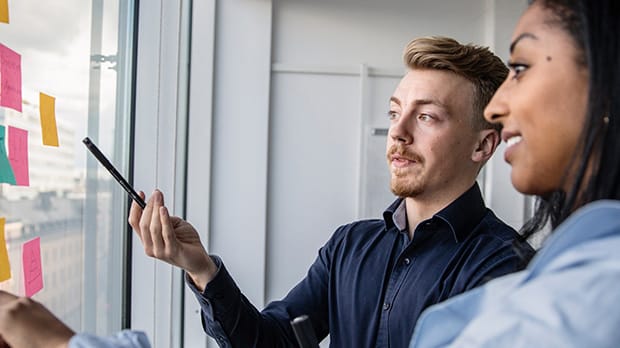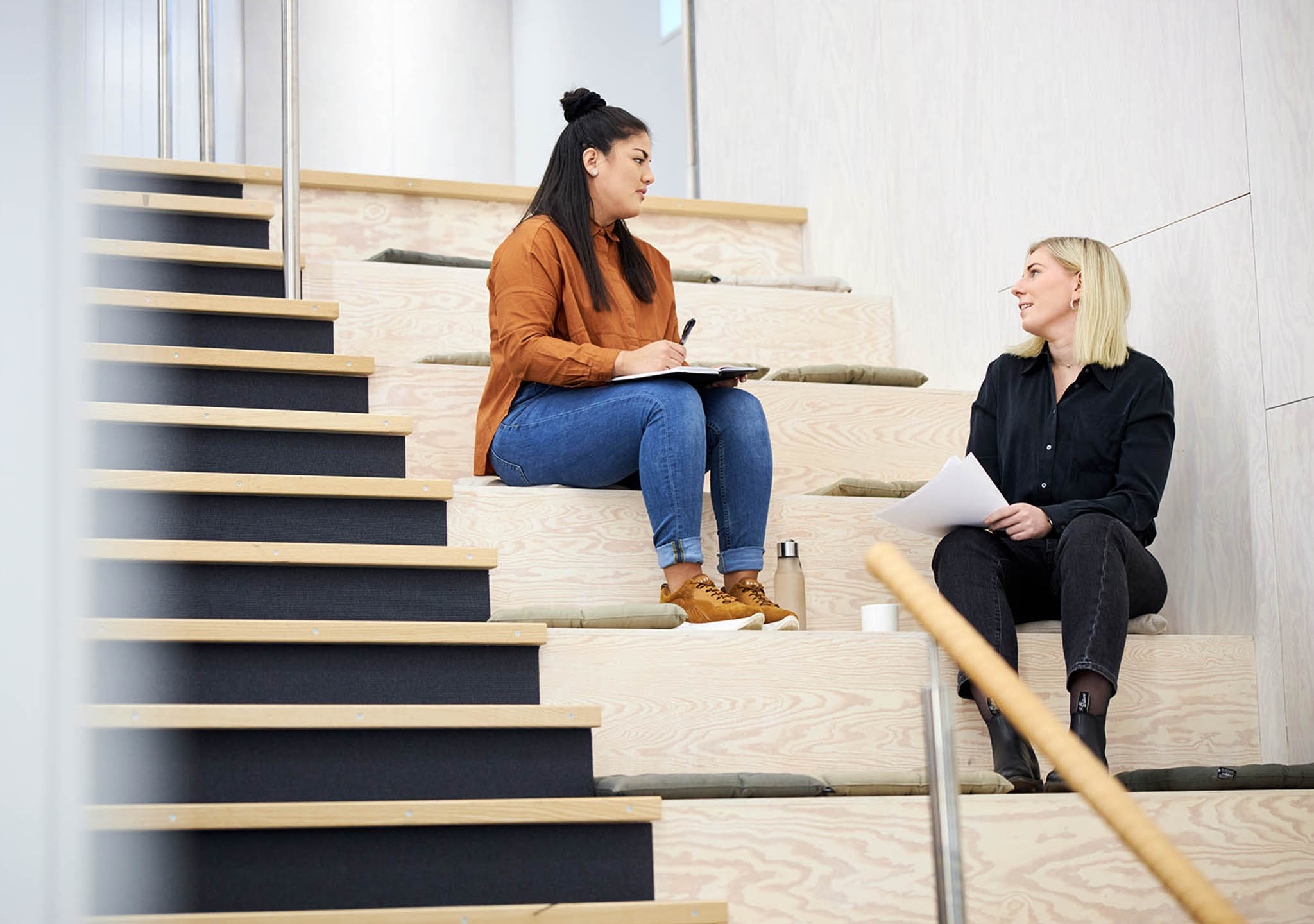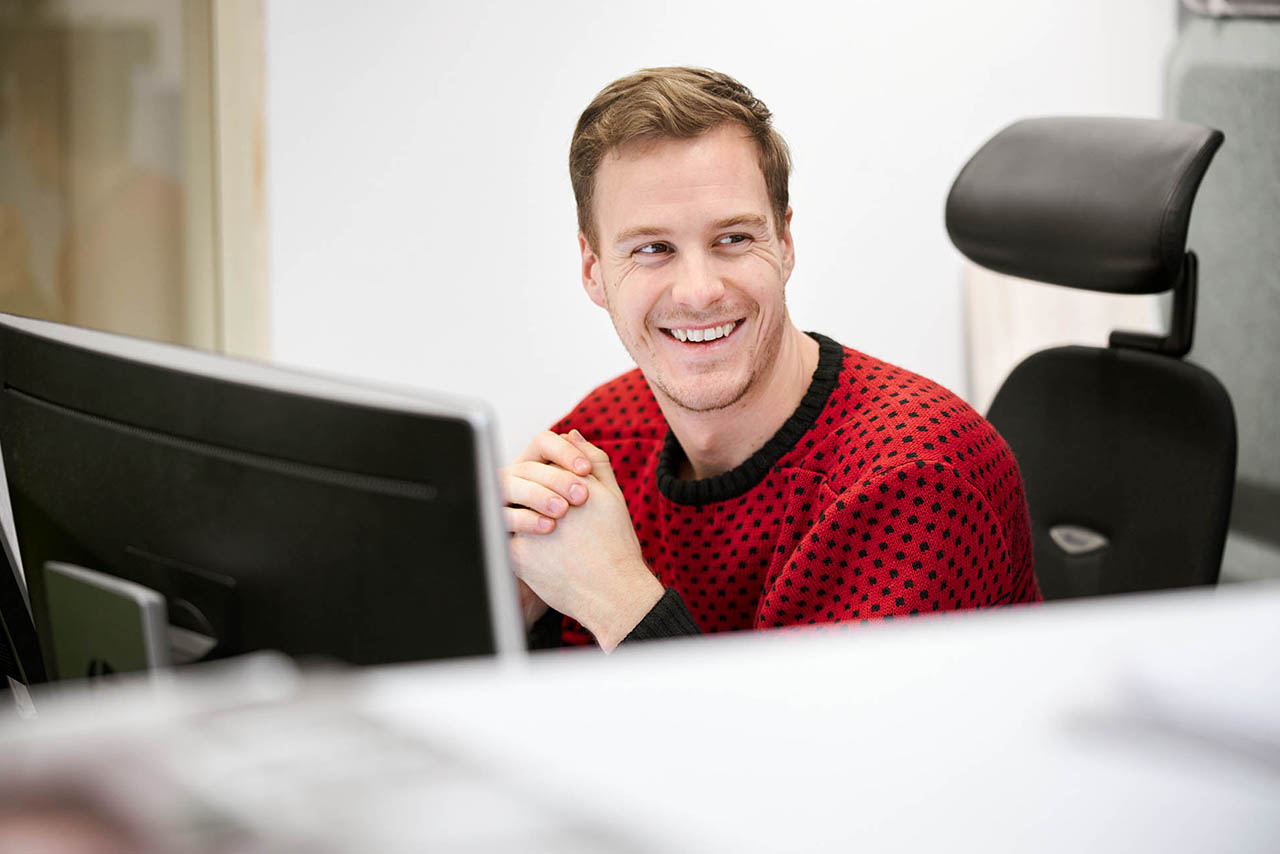
What is the purpose of the office?
To have or not to have, a physical office space – might be the question many companies ask themselves these days. Our flexible and digital way of working during the past year has changed the way we perceive what can pass as a work space. But, post-pandemic, what is really the purpose of a physical office space?
One thing many of us might have lacked this past isolated year, is the culture of a workplace. Even though many of our digital solutions helps us get the job done, it is hard to recreate the dynamics of teamwork and togetherness via the screen. In many positions it has also been difficult to be creative, while sharing a blank document in Teams. That is where the natural waterhole, the office space, is needed and terribly missed.
ENABLES CREATIVE COLLABORATIONS
Workspaces do not need to have unconventional design in order to spark creativity. Foosball tables and slides may look cool, but it is not vital for team creativity or productivity. A creative workplace increases the ability for collaboration, and promotes innovation. But it is really the people behind it that does the magic.
Warren Bennis, late professor at the University of Southern California, describes in his book “Organizing genius: The secrets of creative collaboration ” six creative, innovative incidents in the U.S. during the 20th century. They all took place in very different physical environments; an abandoned warehouse (Walt Disney), an underground bunker (the Manhattan project) and a garage (Hewlett and Packard). The common denominator was the team and the ability to work creatively together.
Another guru in the world of organizational creativity, is Teresa Amabile’s , professor and director of research at Harvard Business School. She states in an interview :
“My research has found that people often do come up with creative ideas and solve complex problems collaboratively by working with other people, and by having their ideas sparked by other people. That is more likely to happen when people are in environments where they run into each other fairly frequently during the workday and in circumstances where they can stand or sit and talk to each other.”
PHYSICAL PAIN AND POSTURE
Another important aspect, that might not have been top of mind for many of us pre-pandemic, is the ergonomics of the workspace. But after spending almost a year at the kitchen table on a wooden chair, our bodies truly feel the difference. In Sweden, sick leave due to physical and mental ailments has increased sharply throughout the beginning of autumn 2020 (according to corporate health company Previa). A serious development for the work environment that does not seem to stop.
The importance of the right ergonomics in the workplace is something interior design and furniture manufacturing company Kinnarps has known for a long time. For nearly 80 years they have created sustainable interior design solutions bearing ergonomics in mind.
– We think it is important to talk about the whole when it comes to ergonomics, both physically and pschycologically says Henrik Axell, Workplace strategist at Kinnarps. There are many different parts that affect how people feel and perform in the office and it’s important to look at the complete experience of a space. A big challenge is to build in movement, since many of us who work in the office sit for many hours every day - which has a clear negative effect on our health. Another important aspect is acoustics. In an office, there should be room for both pulse and silent focus. Both are needed to create an environment that invites collaboration, creativity and innovation as well as concentration, focus and efficiency.
By creating different zones and places for different activities that are needed in the specific office, you can create a dynamic workplace where people can choose environments according to what they are going to do. A well thought out and planned interior design solution which is designed according to mapped needs and work patterns creates the best prerequisites for the employees to feel well, thrive and perform their work in an optimal way.
 "By creating different zones and places for different activities that are needed in the specific office, you can create a dynamic workplace where people can choose environments according to what they are going to do." Henrik Axell, Workplace strategist, Kinnarps
"By creating different zones and places for different activities that are needed in the specific office, you can create a dynamic workplace where people can choose environments according to what they are going to do." Henrik Axell, Workplace strategist, Kinnarps
And when you have the right interior design, you also need the right light. But what is the “right” light?
– The "right light" is utterly individual, says Maja Salinder, Customer Experience Developer at Fagerhults Belysning. For me, ergonomic light is about being able to decide over my own light. It must of course be glare-free and comfortable, but above all, I want to be able to decide over my own light for my workspace. Being able to adjust the direction of the light, its colour temperature and the light level is real light ergonomics for me. This flexibiliyty of light, combined with the ergonomics that Henrik describes, is what I would call a truly ergonomic workplace.
 "Above all, lighting ergonomics for me is to be able to adjust and control the light as I choose. That's what it is there for - to meet my needs." Maja Salinder, Customer Experience Developer Fagerhult
"Above all, lighting ergonomics for me is to be able to adjust and control the light as I choose. That's what it is there for - to meet my needs." Maja Salinder, Customer Experience Developer Fagerhult
FREE TIME, IS ME TIME
One important aspect of going to the office is also - coming home from the office. Having a clear distinction between work and free time is important, psychologically, to be able to recuperate and process. Studies suggests that the real secret to increased efficiency at work might actually lie in resting more . Mental breaks increase productivity, replenish attention, solidify memories and encourage creativity. And to be able to rest from work, it is a clear benefit if you do not have your “work desk” next to your plate of tacos in the kitchen.
Our brain is just like any other muscle in the body, and as such it needs rest to recover. When we rest, we have the time to reflect and review, giving you the opportunity to see work habits or structures that aren’t beneficial for you. A rest day is also a good time to celebrate your accomplishments and refresh your sense of purpose so that you return to work with renewed motivation to get things done.
So, in short, the workspace does not need to look like Googles headquarters (even if it seems like a pretty fun place to do your hours), as long as you have the possibility to randomly bump in to your co-workers by the coffee machine. And do not forget to switch the cell phone off on weekends, and let your brain reboot.
TEXT MARIA VÅRENIUS
FOTO PATRIK SVEDBERG, LISELOTTE VAN DER MEIJS
Relaterade nyheter

Omvänt mentorskap: ”Allt ledarskap handlar om människor”
Under det senaste halvåret har sexton ledare från bolag i Jönköpings län haft varsin mentor via programmet Omvänt Mentorskap. Det som gör det just »omvänt« är att mentorerna är yngre och i början av sina yrkeskarriärer medan adepterna är mer seniora. Kristoffer Emanuelsson, produktionschef på Fagerhult, och Maria Liljeqvist, enhetschef inom hemtjänst i Jönköpings kommun, är ett av mentorsparen. Hej Maria och Kristoffer! Nu är Omvänt mentorskap över, vad har ni haft fokus på i ert samarbete?Kristoffer: ”Vi har inte haft några specifika mål utan har reflekterat och pratat, och så har Maria kommit med inspel på hur jag kan tänka i min vardag.”Maria: ”Jag tycker vi har haft en tydlig tråd där vi utgått från Kristoffers frågeställningar och reflekterat kring dem.” Kristoffer, var det något särskilt som du ville lyfta – och som du tar med dig? ”Jag ville fokusera på hur jag kan engagera kollegor och vi landade i flera diskussioner kring feedback. Det är lätt att fastna i det klassiska »Bra jobbat!« men det kan behövas lite mer utvecklande kommunikation och det vill jag bli bättre på gentemot mina närmaste medarbetare.” Maria flikar in: ”Jag sa till Kristoffer; du får inte säga »Bra jobbat!« om du inte också utvecklar vad som gjordes bra. Det är så lätt att fastna där.” Omvänt mentorskap 1 Att bryta invanda mönster är kan vara en utmaning, hur har det känts att kliva utanför komfortzonen? Kristoffer: ”Redan vid anmälan så bestämde jag mig för att ge detta en verklig chans. Annars är det ju ingen idé! Jag tycker det är viktigt att poängtera att det till stor del hänger på ens egen inställning. Att man verkligen vill, och vågar vara lite obekväm. Vi har haft bra diskussioner och samtidigt väldigt roligt, och det är ju alltid viktigt.” Maria: ”Jag tycker Kristoffer har varit modig och vågat testa de metoder vi diskuterat. Det har gjort att vi hela tiden kommit vidare.” Maria, har du lärt dig något som du tar med dig – utöver din roll som mentor? Maria: ”Ja, absolut! Det är så tydligt, att även om vi jobbar i väldigt olika miljöer så handlar ledarskapet alltid om människor och individer, och hur vi leder dem. Det är en värdefull insikt. Dessutom har vi haft roligt, och jag har stärkts i min egen roll som ledare genom att ha en senior ledare som lyssnar, tar till sig och provar mina idéer och tankar om ledarskap.” Ni jobbar i vitt skilda branscher, har olika lång ledarerfarenhet och är nya bekantskaper för varandra – vad tar ni med er från det? Maria: ”Vi är ganska olika som personer, och det har varit intressant att reflektera kring det i olika scenarier och hur det påverkar ledarskapet. Vi har lärt oss mycket av varandra.” Kristoffer: ”Jag tycker det är viktigt att vara öppen med sina brister, och samtidigt våga tänka nytt. Och kanske lägga eventuella skillnader kring hur länge man har varit ledare eller ålder åt sidan – och fokusera på att själva samtalet ska bli bra. Maria har ställt en del tuffare frågor där jag känt mig lite obekväm, men det har fått mig att ifrågasätta gamla vanor och varför jag gör saker på ett visst sätt. Det har hon gjort väldigt bra.” Kristoffer, utifrån ditt perspektiv som adept – hur ser du på Omvänt mentorskap? ”Inledningsvis kändes det lite obekvämt, men jag tycker man ska ta chansen att söka. Jag kan verkligen rekommendera det. Att ha en mentor var intressant, och det omvända mentorskapet tycker jag var väldigt givande. Att ta sig tid för reflektion med någon som inte har koppling till min vardag öppnar för andra funderingar och frågor. Vi kommer absolut försöka hålla kontakten.”

